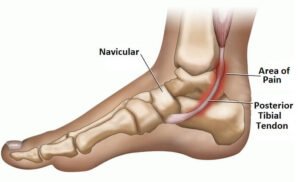What is Tibialis Posterior Tendinopathy / Dysfunction?
Posterior tibialis dysfunction is a condition that affects the main supporting tendon of the arch of the foot. This condition causes a progressive and degenerative change to the structure of the tendon. This condition is commonly seen in people with pes planus or flat feet and is most common amongst middle aged women. Pain is often localised to the inside of the foot behind the medial ankle bone, but can also track up towards the inside of the tibia (shin bone) and can be mistaken for “shin splints”. Posterior tibialis dysfunction is also seen coinciding with other foot conditions such as plantar fasciitis – and is often able to be treated at the same time.

What are the symptoms?
A symptom of tibialis posterior dysfunction includes pain or swellling at the medial (inner side) of the ankle that progressively worsens. The most notable symptom of this condition is a change to the shape of the foot. People who experience this condition often note that their feet have become “flatter” over time.
What causes it?
Pes planus or flat feet is the most common cause of Tibialis Posterior dysfunction due to the increased strain on the small muscle and its tendon. Another common risk factor is obesity which increases the force on the affected tendon. Along with typical tendinopathies, factors such as age, medications and pre-existing health conditions can also increase the risk of developing this condition. Some sports that require unsupportive footwear due to the individual demands of the sport can also increase the risk such as dancing, field based sports, boxing and martial arts and many more.
What is the treatment of Tibialis Posterior dysfunction?
The treatment of tibialis posterior dysfunction requires exercises to rehabilitate the tendon. Targeted exercises will limit the progression of the condition and with some persistence, eliminate it all together. Tendons are what we call ‘avascular structures’; this means that tendons do not have much blood flow. Due to this limitation in blood flow to the tendon, they can take anywhere from 6 to 12 weeks to heal. Good supportive footwear can help with the symptoms however this condition often requires orthotic therapy due to its complex nature. Orthotic therapy is an important component to both aiding recovery and preventing the progression of this condition. Orthotic therapy aims to provide the arch with support, reducing the amount of work the tendon needs to do to support the arch – allowing it to heal. Custom orthotics work best in this case due to the ability of your podiatrist to tailor the correction and support tot your individual mechanics and foot shape.

Without treatment of this condition, there can be a total rupture of the tendon and complete collapse of the arch. This often results in surgery and an extensive rehabilitation process. Along with this is an increased likelihood of the development of osteoarthritis to the joints of the ankle and foot. Book an appointment and talk to one of our expert podiatrists today.
